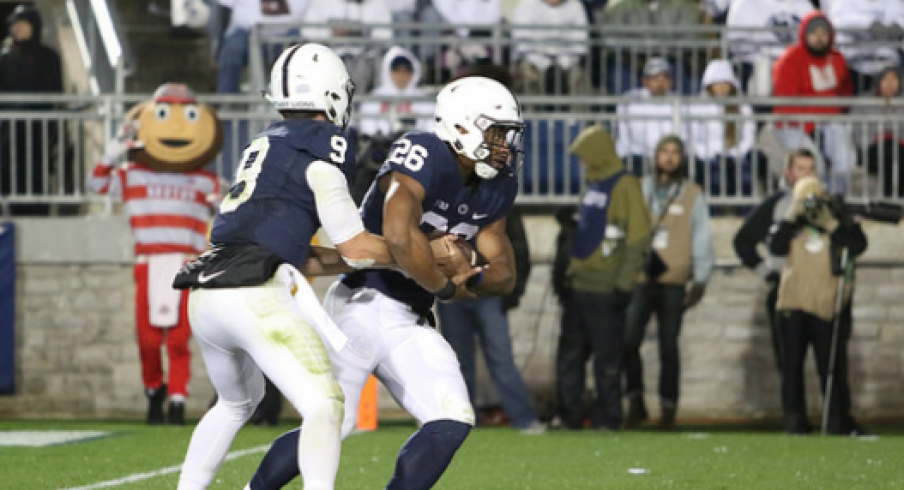In 2016 Head Coach James Franklin hired offensive coordinator Joe Moorhead from Fordham University to reignite the Nittany Lion offense.
Moorhead did not disappoint as Penn State averaged 435.6 YPG, an increase of 87.2 YPG from the previous season.
But while watching Penn State it is apparent that the offense resembles much of what is seen in Columbus. The Nittany Lions heavily used 11 Personnel (1RB-1TE) with the TE being moved around the formation in Y-Off alignments, on the line in a three-point stance, and even flexed out wide in a trips set much like the Buckeyes did in 2016 with Marcus Baugh.
Under Moorhead, Penn State has relied on three base run plays: Inside zone, Dart/Dart-Cutback and Power Read.
Inside Zone
Inside zone is the play Moorhead hangs his hat on as it accounts for a large percentage of their run game. While playing quite a few teams that run a defense similar to Ohio State's 4-3 quarters defense, the Nittany Lions enjoyed a fair share of inside zone weak.
It is worth noting that Michigan State and Rutgers run a similar defense to the Buckeyes, as does Pittsburgh, an out-of-conference opponent of Penn State. Pictured below is how Penn State runs their inside zone play out of Trips:
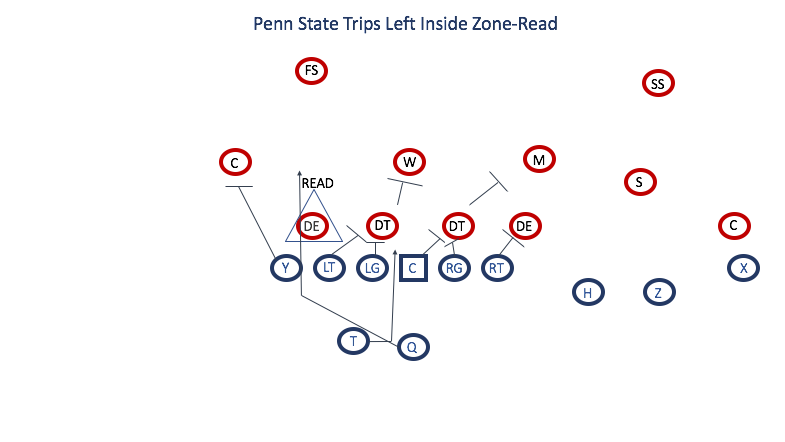
With an inside zone play, the offensive line is stepping to their play side gap. The right tackle is has a base block on the defensive end while the right guard and center are double-teaming the 3-technique to the Mike linebacker. The left guard and left tackle are double-teaming the 2i to the Will linebacker with the tight end is arc releasing on a base block to the corner who is aligned 3x5 yards off the line of scrimmage.
The quarterback will catch the snap and take a step forward as he is reading the defensive end for a "give" or "keep" read. The quarterback will give the ball to the running back but if the defensive end squeezes down to tackle the running back, the quarterback will pull the ball and follow the tight end.
Against the Buckeyes, Penn State dialed up a wrinkle of their inside zone weak game this time out of a Trey formation. On the play, the quarterback is still reading the defensive end for a "give" or "keep" read. After the defensive end collapses and McSorely keeps the ball, he is now reading the corner for a "keep" or "throw" read.
This play was popularized by Auburn in 2014 as they ran it for a touchdown against Alabama in the infamous kick-six game. Here is the play from Auburn's 2013 Offensive playbook:
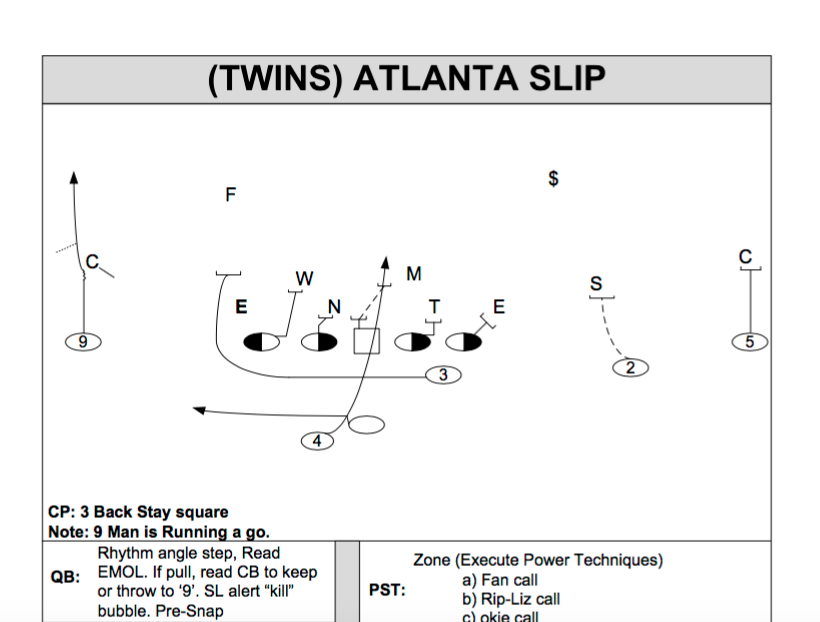
Dart
Besides inside zone, the Nittany Lions run a fair share of Dart and Dart-Cutback. The Dart concept at its core is a play that utilizes a tackle isolation block on a linebacker. At first glance, the play looks like one-back power, but it involves the backside tackle pulling around instead of the guard.
Defenses understood that Moorhead wanted to run his inside zone play at the 3-technique so they countered that by setting the 3-technique to the running back's side. This allowed Penn State to run their Dart play with good blocking angles.
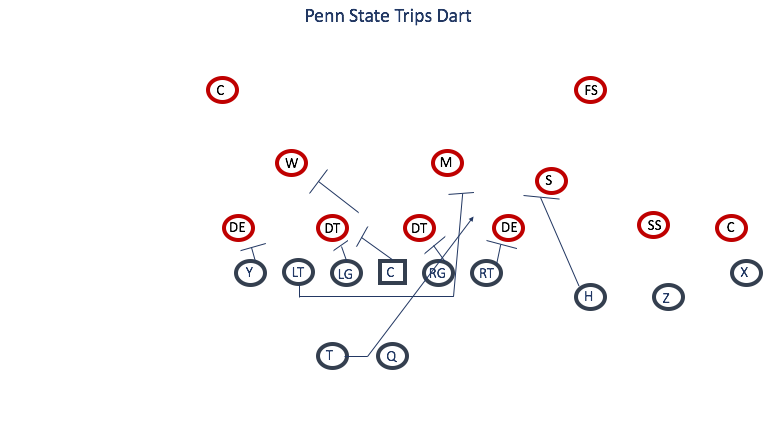
Penn State continued to call this play, at times running it towards the side of the back with the running back on counter footwork. This play is known as Dart-Cutback. The counter footwork by the Running Back works to hold the Linebackers while the Offensive Line works to them.
The Y-off alignment assists in keeping the Defensive End from penetrating from where the pulling Tackle's side.
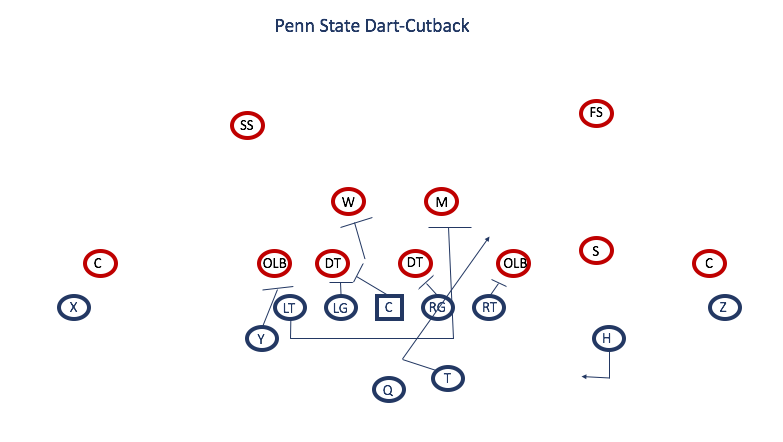
To keep players out of the alley and the box number even, Moorhead turned to RPOs (Run-Pass Options) out of the Dart play.
On the following play, the Quarterback is reading the Mike linebacker which is apexed between the Right Tackle and the #3 Wide Receiver. The Linebacker commits to the run so the Quarterback pulls the ball and throws the smoke screen to the Wide Receiver:
On the Dart play below the Quarterback is reading the Sam linebacker who is flexed in between the Tight End and the #2 Wide Receiver. If the Sam commits to the run, the Quarterback will pull the ball and throw the out route to the #2 Wide Receiver in the trips set:
Power-Read
Since Urban Meyer's arrival to Columbus in 2012, Ohio State has ran the Power-Read play as a staple of their offense. While studying Joe Moorhead's offense it was apparent that the Nittany Lions value this play just as much. The Power-Read play is blocked like power up front with the frontside Defensive End being left unblocked as the Quarterback reads the defensive end for a "give" or "pull" read.
Penn State chooses to block the play solid with the backside guard pulling around to kick-out the defensive end while the quarterback reads the Will linebacker for a "give" or "pull" read. If the Will flows towards the sweep, the Quarterback will pull the ball and run the power play. If the Will linebacker stays inside the box, the Quarterback will give the sweep to the Running Back.
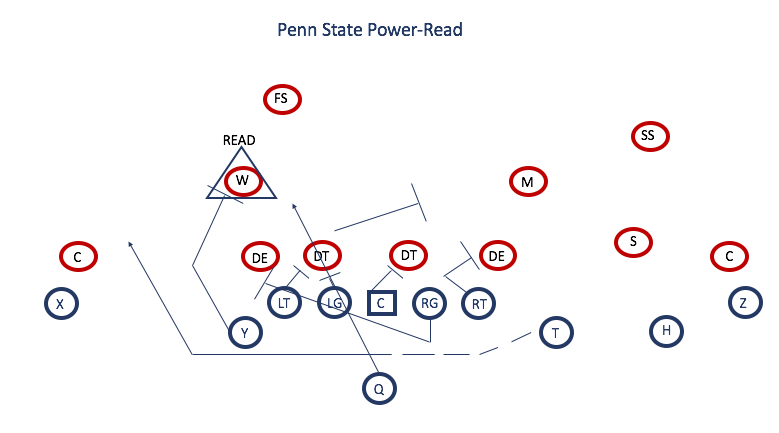
Prior to running Power-Read out of Trey, Moorhead dialed up a Power-Read RPO (Run-Pass Option) in which the Quarterback was reading the Mike linebacker. When Penn State lined up in a Trey set with the tight end flexed out wide as #3 in the trips set, the Mike linebacker is responsible for carrying #3 vertical but was also the force player against the run.
If the Mike linebacker carries the vertical route by the Tight End, the Quarterback would give the sweep play to the Running Back. However if the Mike linebacker commits to the run, the Quarterback would pull the ball and throw the seam route to the Tight End. On the following play the Mike linebacker, Raekwon McMillan, commits to defending the Power-Read run so the Quarterback pulls the ball and throws the seam route to the Tight End:
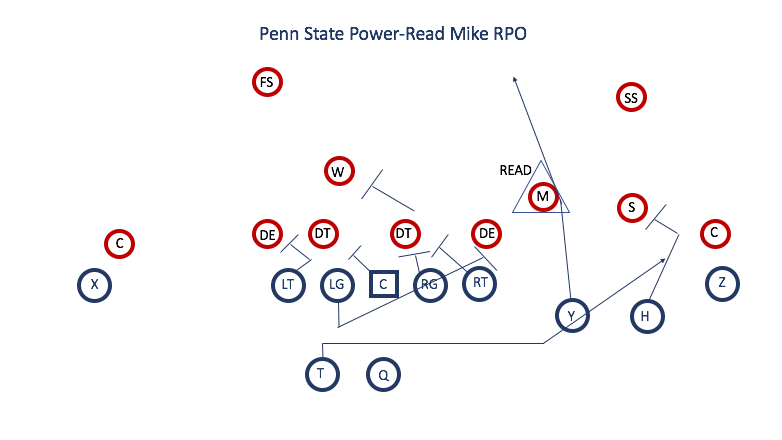
Play-Action Passing Game
In 2016 under Joe Moorhead, Penn State's offense was reliant on explosive plays, especially through play-action. The Nittany Lions mostly used play-action passes with 7-man protections and 3-man route concepts and Moorhead was most likely to dial up a play-pass in between the 40-yard lines and coming off of a first down such as the play below.
Against Michigan State, Moorhead dialed up a 7-man protection Split-Zone play-action coming off of a first down using tempo. Michigan State is playing their quarters defense, meaning the corners and safeties are responsible for playing #1 and #2 vertical.
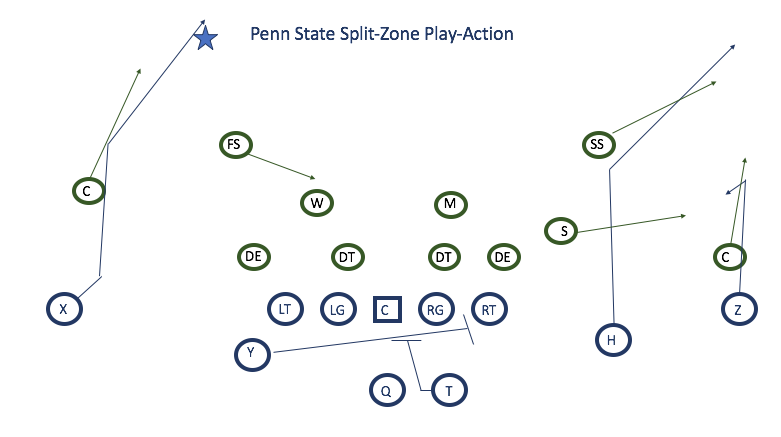
Once the tight end goes across the formation on a wham block on the play-action, the free safety follows the tight end opening up the middle of the field for a one-on-one with the wide receiver and corner. The corner route by the 'H' receiver keeps the strong safety from helping the corner in the middle of the field due to his responsibility to play #2 vertical.
The wide receiver does a great job of releasing on an inside stem to create leverage against the corner. The receiver runs directly at the corner's feet creating a tough match-up for him as the wideout has leverage to run a corner route or a deep post (as pictured below). The quarterback throws a great ball to the vacated middle of the field allowing his receiver to run to the open space.
Below is an example where Penn State ran a Split-Zone play-action pass where the boundary corner was playing over the top of the receiver, so he cut his route off and ran a comeback towards the sideline instead.
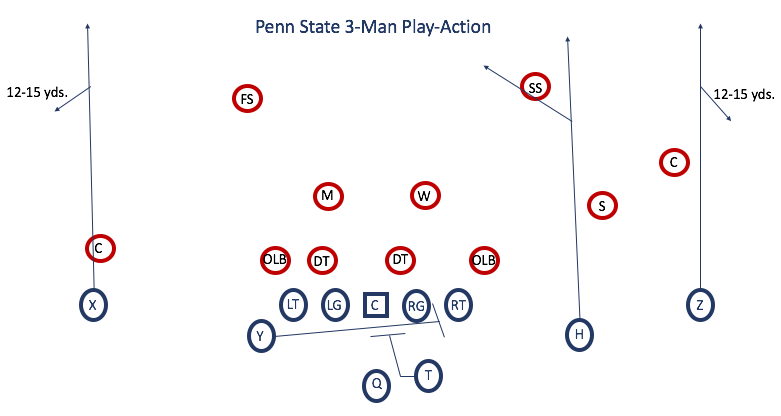
This is another example versus Pittsburgh in which the wide receiver beats the corner, so he continues on the fade route as the quarterback throws the ball up to give his receiver a chance to go get it.
Last season Penn State struggled to move the ball early in games but often found their rhythm late. With the addition of Joe Moorhead as offensive coordinator, Penn State returned to national relevance.
The game of football is ultimately a player's game but the coaches are responsible for putting the players in position to have success.
This is Zach Dunn's first contribution as a member of 11W's Film Study team. You can follow him at @ZachSDunn.
